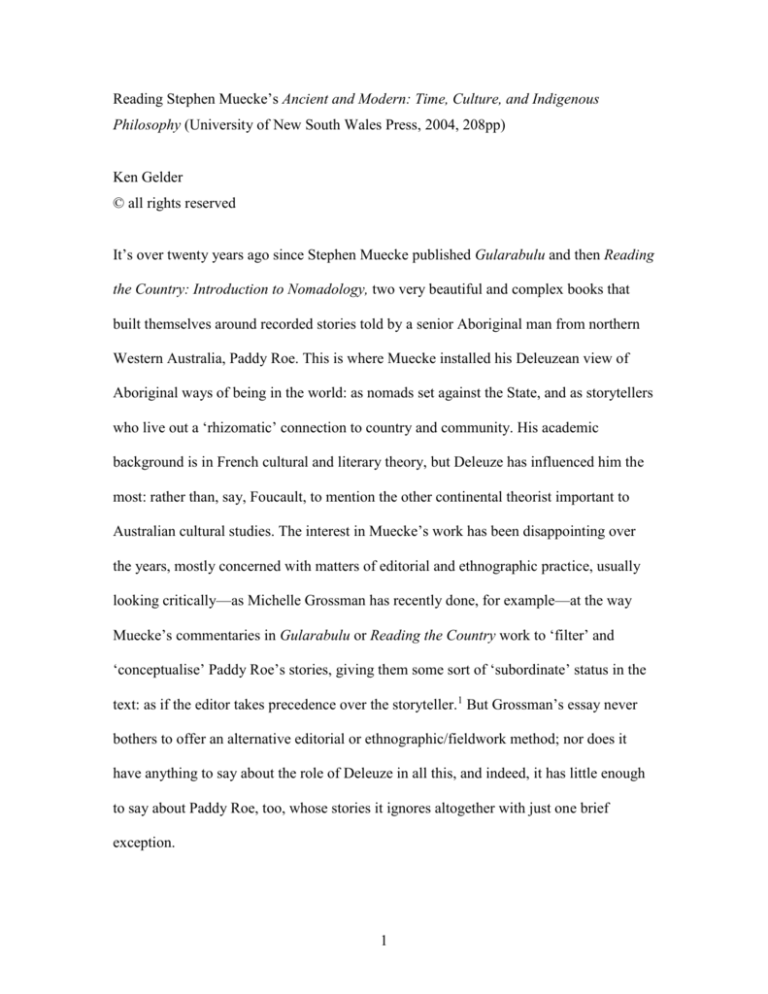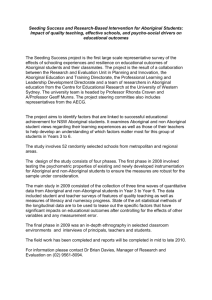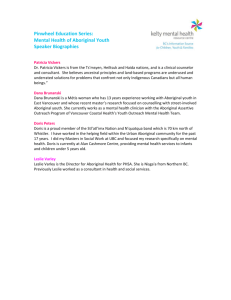
Reading Stephen Muecke’s Ancient and Modern: Time, Culture, and Indigenous
Philosophy (University of New South Wales Press, 2004, 208pp)
Ken Gelder
© all rights reserved
It’s over twenty years ago since Stephen Muecke published Gularabulu and then Reading
the Country: Introduction to Nomadology, two very beautiful and complex books that
built themselves around recorded stories told by a senior Aboriginal man from northern
Western Australia, Paddy Roe. This is where Muecke installed his Deleuzean view of
Aboriginal ways of being in the world: as nomads set against the State, and as storytellers
who live out a ‘rhizomatic’ connection to country and community. His academic
background is in French cultural and literary theory, but Deleuze has influenced him the
most: rather than, say, Foucault, to mention the other continental theorist important to
Australian cultural studies. The interest in Muecke’s work has been disappointing over
the years, mostly concerned with matters of editorial and ethnographic practice, usually
looking critically—as Michelle Grossman has recently done, for example—at the way
Muecke’s commentaries in Gularabulu or Reading the Country work to ‘filter’ and
‘conceptualise’ Paddy Roe’s stories, giving them some sort of ‘subordinate’ status in the
text: as if the editor takes precedence over the storyteller.1 But Grossman’s essay never
bothers to offer an alternative editorial or ethnographic/fieldwork method; nor does it
have anything to say about the role of Deleuze in all this, and indeed, it has little enough
to say about Paddy Roe, too, whose stories it ignores altogether with just one brief
exception.
1
It’s worth noting that in Australian literary studies, non-Aboriginal readings of
Aboriginal stories generally and unsurprisingly end up being about non-Aboriginality: a
way of thinking about ‘whiteness’, for example, rather than a chance to meditate on
Aboriginality or on ‘being Aboriginal’. These kinds of readings, in other words, are
generally self-reflective. But in Stephen Muecke’s latest book, Ancient and Modern, we
get quite the opposite procedure: an ambitious non-Aboriginal or ‘whitefella’ attempt to
describe ‘being Aboriginal’ and to account for what Muecke calls Aboriginal philosophy.
Muecke remains Deleuzean in this latest work, even speaking about the latter’s
‘reterritorialisation’ in Australia. Whereas Reading the Country had placed Paddy Roe’s
stories and Muecke’s Deleuzean commentaries side by side, this new book is, I think, an
attempt to become Deleuzean and Aboriginal simultaneously, to somehow fold these two
realms together almost to the point of indistinguishability. Indeed, this is Muecke’s
primary method here: to entangle continental theory with Aboriginal practice. A chapter
about another senior Aboriginal man is called ‘Boxer, Deconstructionist’, in which we
are told that Boxer’s stories have ‘the power that is often attributed to European
theories’.2 Aboriginal people might very well be surprised to find themselves recast in
this way, but Muecke is as enthralled by their stories as he is by the continental theory he
brings to bear upon them. It can often seem as if by one he really means the other, and
vice versa: this is the strategy he brings to the topic of ‘being Aboriginal’, and it is
probably fair to say that sometimes it pays off and sometimes it doesn’t.
Using Deleuze to read Aboriginal stories and philosophies may seem idiosyncratic, but in
fact it works to situate Muecke’s approach in a very specific Australian context. One of
2
the keywords in Ancient and Modern is ‘vitalism’, taken from Deleuze but via Henri
Bergson, who had influenced some earlier Australian literary and cultural critics, as well
as several artists and poets: such as William Baylebridge, or Vincent Buckley whose
early essay ‘Utopianism and Vitalism in Australian Literature’ was published in the
conservative journal Quadrant in 1959. It is true to say that the champions of vitalism in
Australian Literature have not on the whole been politically progressive. But Deleuze’s
‘vitalist philosophy’ helps Muecke to emphasise his sense that Aboriginal people are
defined through life-forces, movement, vigour, immediacy, connectedness,
metamorphosis and ‘becoming’. Aboriginal people are immersed in country: bodies and
landscape, for Muecke, flow back and forth into one another. Such a view is not really
very far away from some of the ‘Jindyworobak’ poets from around the 1940s, for
example, who were also absorbed by Aboriginal vitality. But to invoke it now is to take a
certain risk, especially in terms of its earlier currency in Australia. For one thing, this
view is purely cultural. Muecke emphasises what he calls an Aboriginal ‘poetics’, and
poetry itself is important to him as a measure of authenticity when he analyses Aboriginal
narratives and practices. A sequence in Philip Noyce’s Australian film Backroads (1977)
where Aboriginal and non-Aboriginal characters argue about racism is given value
precisely because it seems like ‘a certain kind of poetry’ (p.91). On the other hand,
Muecke has very little direct interest in the political, progressive or otherwise: so (for
example) he has nothing much to say about land claims and other contemporary
expressions of Aboriginal political-philosophical will. He touches very briefly on some
recent commentaries that argue for Aboriginal self-dependence and he speaks for a brief
moment about ‘Aboriginal capitalism’. But he mostly carves out a space for Aboriginal
3
people that is free from these things, and which is almost entirely cultural—we might
even say entirely literary—in its conception.
Drawing loosely on Dipesh Chakrabarty, Muecke suggests that Aboriginal people inhabit
an ‘alternative modernity’ to non-Aboriginal Australians. This alternative modernity is
linked to the ‘ancient’ which Muecke mobilises as a powerful force in Aboriginal
philosophical expression and which underwrites his sense of Aboriginal vitalism. It is
tied to ritual and magic, that is, it is cultural. Muecke quotes José Gil, whose work he has
translated from the French, who writes that the earth is a ‘magical territory perceived in
the extension of the community body in relation to the ancestors’ (cited p.117) - and this
pretty much summarises Muecke’s position on Aboriginal philosophy, even though the
point is registered unevenly through this book. ‘We have not left intuition and magic
behind in our secular world’ (p.161), he tells us, buying into the familiar thesis that the
Enlightenment carries its shadows along with it. Many might agree with him here, but the
point can also lead to a number of troubling mystifications. The modern West, for
Muecke, values rationality and objectivity, while Aboriginal people ‘are connected
singularly to feeling, intuition’ (p.170). This is a binary that indigenous people, as well as
women, for example, have had to live with for some time. We could say that in spite of
his commitment to deconstruction and continental theory, Muecke is therefore
‘metaphysical’ about Aboriginal philosophy. Non-Aboriginal modernity is routinely cast
as superficial, ephemeral, atomizing; indigenous modernity, on the other hand, is
grounded in the ancient and therefore has ‘depth’ and ‘permanence’, much like ‘images
from an epic poem’ (p.12) and testifying to ‘the deeper flow of fundamental narratives’
4
(p.163). The perspective is surprisingly essentialist, for all its theoretical interest in flux
and change and Deleuzean ‘rhizomes’ and ‘becoming’.
I think that this essentialism arises in part from Muecke’s tendency to slide from
modernity to modernism in his book: returning over and over to modernism’s high
literary values in the midst of a world otherwise given over to information technologies,
commodification and disposability. This is where he takes his valorisation of the poetic,
for example, with its respect for tradition and ritual and its sense that modern, secular
society is alienated from ancient, buried wisdoms. He admires the Aboriginal artist
Gordon Bennett, for example, because he ‘remains within a modernist project’ (p.150).
Modernity, for Muecke, is defined in terms of consumerism and textual interpretation,
producing ‘modern affects’ such as ‘cynicism, irony and insincerity’ (p.76). Aboriginal
art and narratives are distinguished from all this—which means amongst other things that
Muecke has no time for postmodern Aboriginal cultural production, like the work of
Tracy Moffatt or Destiny Deacon which he never mentions. Can Aboriginal cultural
producers be ironic? Not in Muecke’s schema, it would seem. He prefers instead a model
of mimesis that he takes from the anthropologist Michael Taussig, where what you see is
exactly what you get. Just as Roland Barthes had once described poetry, so Aboriginal
ritual and practice for Muecke is pure signification. There is no act of representation or
mediation involved, just total immersion in the thing-in-itself. An Aboriginal painting, for
example, embodies (rather than, say, symbolises) country and carries ‘that country’s
vitality (power-to-grow) with it always’ (p.21). This is in some respects a compelling
view, but it runs the risk of mystification—and it relies utterly on a commitment to a
5
sense of Aboriginal-immersion-in-country that remains untouched by colonialism (and,
we might add, by modernity): as if dispossession (which we might think of here as
producing disjuncture between signifier and signified) simply didn’t happen. On the other
hand, there may be nothing particularly Aboriginal about this at all. Another example of
this kind of art for Muecke is the work of the non-Aboriginal Queensland painter, Bill
Robinson. Robinson is a rural mystic whose paintings are often infused with a lyrical
kind of Christian fundamentalism. I’m not entirely sure why he features in Muecke’s
book. Even so, Muecke finds in his paintings the same philosophy of unmediated
expression, requiring the viewer (rather as Susan Sontag had once urged) to forego
interpretation: as if, away from the cities at least, non-Aboriginal painters can be just as
indigenous as their Aboriginal counterparts.
In the past, Muecke has worked mostly with senior Aboriginal men from remote
locations—Paddy Roe, ‘Butcher’ Joe Nangan—which means that he talks primarily
about traditional male Aboriginal world-views of country. He is therefore sometimes also
criticised for having little to say about contemporary Aboriginal cultural practices.
Ancient and Modern is in part a response to this, but it retains its focus on senior
Aboriginal men (Paddy Roe, Boxer, David Unaipon, Albert Namatjira) and its notion of
an Aboriginal ‘alternative modernity’ is essentially a nostalgic one. It pitches an
Aboriginal Geimenschaft against the alienating Gessellschaft of modern Australia.
Indeed, having distinguished Aborigines from what he calls modernity’s ‘commodity
production and novelty’ (p.76), Muecke defines them precisely in terms of Ferdinand
Tonnies’ end-of-the-nineteenth century notion of the Volk’s community, with its
6
connotations of unmediated exchange, authenticity, organically inherited traditions and
rituals, ‘the network of kin relationships’ (p.75), and obligatory rural settings. There is
nothing in this book on metropolitan Aboriginal cultural production and Aboriginal uses
of new media and new technologies: the urbane cinematic ironies of Tracy Moffatt, as
I’ve said, simply go unnoticed. And there is no register of what Alan McKee not long ago
called ‘Aboriginal banality’, the notion that Aboriginal people need not always carry the
weight of their traditions and the signifiers of their ethnicity around with them.3
Are Aboriginal people always condemned to perform ritualistically? In the wake of the
Sydney Olympic Games’ opening ceremony, this has a particular resonance: must
Aboriginal people always be asked to invoke ‘the force of the ancient’ (p.146)? In
Muecke’s study the answer seems to be yes: his Aboriginal examples are therefore more
fatal than banal, to borrow McKee’s borrowing of Baudrillard’s terms. On the cover of
Muecke’s book is artist Brook Andrew’s digital image of an Aboriginal man stylised to
connote the ‘primitive’ with the words ‘sexy and dangerous’ printed across his chest.
This otherwise ironic image precisely expresses Muecke’s notion of Aboriginal
modernity, which is all about ‘the surfacing of the “primitive”’ in the midst of modern
life (p.133). He takes his point from Michael Taussig, who he greatly admires; but this
entangled binary has a longer history that has a great deal more to do with the
development of the western metropolis and goes at least as far back as Henry Mayhew
and the appropriation of anthropological racialisations as a way of distinguishing between
(in Mayhew’s case) the sedentary and the nomadic: the latter applied to itinerant workers,
street performers, prostitutes, beggars, Gypsies, Jewish and Irish immigrants, and so on: a
7
whole spectrum of urban subcultures which were themselves seen to shadow the
Enlightenment. In the frame of all this, it is worth asking: what exactly is modern about
Muecke’s Aboriginal philosophers? He juggles two positions here, continuity and
innovation. ‘Aboriginal philosophy’, he writes, ‘is all about keeping things alive in their
place’ (p.22), a ‘vitalist’ point that might nevertheless seem to condemn Aboriginal
people to eternal repetition. At the same time, Aborigines are—much in the traditions of
cultural studies— ‘cultural innovators’ (p.127) who can adapt their cults and rituals to
suit their circumstances. This is not really a mode of resistance, but it is also not quite an
expression of assimilation—which Muecke speaks passionately against in his book. The
problem is that it is difficult to know just how different Muecke wants Aboriginal people
to be. They have what non-Aboriginal people lack: that is, the ‘ancient’. This provides
them with an ‘alternative modernity’ in contemporary Australia, a ‘counterpoint’ of
radical distinction. On the other hand, Aboriginal rituals can ‘unify the nation’ because,
Muecke says, ‘we can all know [the ancient] in the same way’ (p.10). His commitment to
cultural difference sits uneasily alongside these occasional yearnings for national unity—
and he is not alone these days in wishing that all Australians could be equally
‘indigenous’: a yearning for what we might call non-hybridity, much like the
valorisations these days of the authenticity of the Australian ‘native-born’ by writers like
Peter Read or John Molony. We still don’t have an effective and productive way of
conceiving of Aboriginal hybridity or of understanding ‘being Aboriginal’ without
attaching this to a Tonniesian sense of Gemeinschaft (community) which its connotations
of ancientness, relic, and rurality: producing not so much an ‘alternative modernity’ as
something other to modernity altogether. And ‘banality’ alone is not the answer.
8
Muecke’s book seems only partially aware of its contradictions, it seems to me. It warns
against ‘the trap of romanticism’ (p.76) when examining Aboriginal culture, but its
account of Aboriginal vitalism is itself a romantic one. It wants to speak up for flux and
uncertainty and heterogeneity, yet it invests in the ‘eternal’, in continuity and essence,
and in the truth of ‘fundamental narratives’. It mocks those commentators who drop
phrases from continental theory into their work, yet it routinely speaks of ‘rhizomes’,
‘molar aggregates’ and so on, dutifully following Deleuze. On the other hand, this is a
book that has a lot to say and, bearing out its fondness for nomadic movement, it
certainly gets around: from Sydney to Broome and back again. What remains
unanswered, however, is the question of why—and through what protocols—a nonAboriginal man takes it upon himself to articulate Aboriginal philosophy in the first
place. The issue is raised at one point, when Muecke quotes the senior Queensland
Aboriginal woman, Jackie Huggins, who asks precisely why a whitefella should presume
to account for Aboriginal world-views. But the query is left hanging as Muecke moves on
to another topic: since this is not a self-reflective book. I recalled Huggins’ complaint
when I got to the last couple of paragraphs of Ancient and Modern, where Muecke
curiously relates a dream he once had. As a teacher, he was surprised to see two young
Aboriginal women performing an unusual ritual in his classroom. Later in his dream, he
remembers one of the Aboriginal women (‘Jackie was her name’) sending him an email
to ask if she could perform this ritual as part of her class presentation. He doesn’t reply
and then forgets about her email entirely: ‘…and then it slips one’s mind’ (p.178), he
writes. This is, inexplicably and strangely, the last line of Muecke’s book. Other readers
9
will have their own views about this dream. I would simply note here that it is, perhaps
significantly, one of only a few places in his study where he turns his attention to
Aboriginal women: only to ignore what they say, as he had with Jackie Huggins. I would
also want to say something about that email and the displacement of Aboriginal ritual—
women’s ritual—into a metropolitan university classroom, which seems to me like a good
place to begin a book on Aboriginal modernity, rather than to end it.
Ken Gelder is Professor of English and Cultural Studies at the University of Melbourne,
Australia. His most recent books are Popular Fiction: The Logics and Practices of a
Literary Field (2004) and, as editor, The Subcultures Reader: Second Edition (2005),
both published by Routledge.
1
Michelle Grossman, ‘Beyond Orality and Literacy: Textuality, Modernity and
Representation in Gularabulu: Stories from the West Kimberley’, Journal of Australian
Studies, 81 (2004): http://www.api-network.com/cgi-bin/page?archives/jas81_grossman
2
Stephen Muecke, Ancient and Modern: Time, Culture, and Indigenous Philosophy,
Sydney: UNSW Press, 2004: 131. Further page references will be incorporated into the
text.
3
Alan McKee, ‘”The Aboriginal Version of Ken Done…”: Banal Aboriginal Identities in
Australia’, Cultural Studies, 11 (May 1997).
Other essays/responses in Australian Humanities Review relating to this
issue:
Issue 26: June – August 2002 Fiona Probyn's review of Lynne Hume's
Ancestral Power: The Dreaming, Consciousness and Aboriginal Australia;
Issue 35: June 2005 Anne Brewster's essay ‘Writing whiteness: the personal
turn.’
Issue 31-32: April 2004 "Rabbit-Proof Fence and the Commodification of
Indigenous Experience" by Emily Potter and Kay Schaffer
10
Issue 30: October 2003 Michele Grossman's 'One man's history is another
woman's lie'
Issue 14: July - September 1999 Cracking Up by Hannah Fink
In Australian Humanities Review, see also
the Indigenous Issues archive.
11










